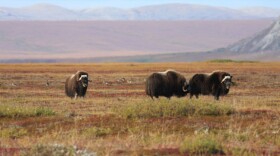-
According to federal court documents, 66-year-old Matthew Owen transported caribou hunters in the Noatak National Preserve, located about 100 miles north of Kotzebue, in 2019 and 2020. His wife, Julie Owen, 60, is charged with one count of providing false information and one count of a permit violation.
-
Polar bear sightings in Kotzebue aren’t without precedent. In fact, the world’s largest documented polar bear was found in Kotzebue in the 60s, weighing more than 2,200 pounds and standing more than 11 feet high.
-
Federal appeals court rules Trump administration was wrong to reverse protections for Pacific walrusThe ruling comes more than a decade after the Center for Biological Diversity, a conservation group, first petitioned the U.S. Fish and Wildlife Service to list the walrus as endangered or threatened.
-
Brittany Sweeney of the Selawik National Wildlife Refuge says the annual Bird Sighting Contest helps scientists pick up changes in bird migration patterns.
-
A new study has found evidence connecting the rapid warming of the region with a physical decline in three species of Alaska seals.
-
Maija Katak Lukin is Inupiaq and grew up in Kotzebue and the Sisualik fish camp, where she’s spent her life subsistence hunting, fishing and gathering. She says her work balances the land stewardship of her ancestors with more modern federal protections.
-
The Bering, Chukchi and Beaufort Seas are home to a variety of marine mammals, including bearded and ringed seals. Though both species are in relative abundance, long-term projections forecast a threat to the once-extensive sea ice the seals live on.
-
The Obama administration listed the Arctic ringed seal under the Endangered Species Act in 2012, citing the effects of climate change on the ringed seal’s sea ice habitat.
-
For subsistence hunters in the northern parts of Alaska, the bowhead whale has been a part of their diet for generations. However, scientists have found that as sea ice has dwindled in Arctic waters, a new predator has moved in to feed on the marine mammals: killer whales.
-
Since 2007, walruses have been hauling out on land between their hunts. Before then, they’d populate sea ice patches throughout the Arctic. Fish and Wildlife spokeswoman Andrea Medeiros says that sea ice hasn’t been as reliable in recent years.
Play Live Radio
Next Up:
0:00
0:00
Available On Air Stations










